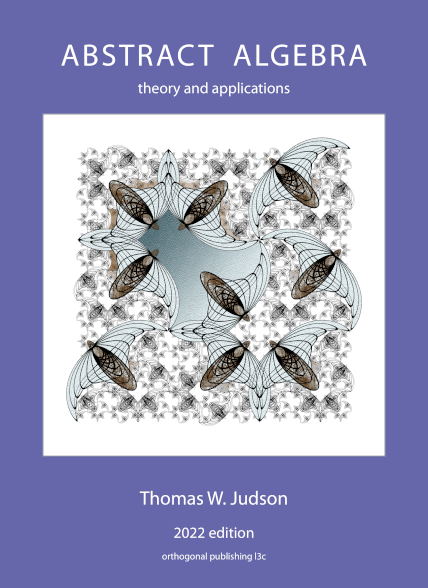Section 10.1 Factor Groups and Normal Subgroups
Subsection Normal Subgroups
A subgroup \(H\) of a group \(G\) is normal in G if \(gH = Hg\) for all \(g \in G\text{.}\) That is, a normal subgroup of a group \(G\) is one in which the right and left cosets are precisely the same.
Example 10.1.
Let \(G\) be an abelian group. Every subgroup \(H\) of \(G\) is a normal subgroup. Since \(gh = hg\) for all \(g \in G\) and \(h \in H\text{,}\) it will always be the case that \(gH = Hg\text{.}\)
Example 10.2.
Let \(H\) be the subgroup of \(S_3\) consisting of elements \((1)\) and \((12)\text{.}\) Since
\(H\) cannot be a normal subgroup of \(S_3\text{.}\) However, the subgroup \(N\text{,}\) consisting of the permutations \((1)\text{,}\) \((1 \, 2 \, 3)\text{,}\) and \((1 \, 3 \, 2)\text{,}\) is normal since the cosets of \(N\) are
The following theorem is fundamental to our understanding of normal subgroups.
Theorem 10.3.
Let \(G\) be a group and \(N\) be a subgroup of \(G\text{.}\) Then the following statements are equivalent.
The subgroup \(N\) is normal in \(G\text{.}\)
For all \(g \in G\text{,}\) \(gNg^{-1} \subset N\text{.}\)
For all \(g \in G\text{,}\) \(gNg^{-1} = N\text{.}\)
Proof.
(1) \(\Rightarrow\) (2). Since \(N\) is normal in \(G\text{,}\) \(gN = Ng\) for all \(g \in G\text{.}\) Hence, for a given \(g \in G\) and \(n \in N\text{,}\) there exists an \(n'\) in \(N\) such that \(g n = n' g\text{.}\) Therefore, \(gng^{-1} = n' \in N\) or \(gNg^{-1} \subset N\text{.}\)
(2) \(\Rightarrow\) (3). Let \(g \in G\text{.}\) Since \(gNg^{-1} \subset N\text{,}\) we need only show \(N \subset gNg^{-1}\text{.}\) For \(n \in N\text{,}\) \(g^{-1}ng=g^{-1}n(g^{-1})^{-1} \in N\text{.}\) Hence, \(g^{-1}ng = n'\) for some \(n' \in N\text{.}\) Therefore, \(n = g n' g^{-1}\) is in \(g N g^{-1}\text{.}\)
(3) \(\Rightarrow\) (1). Suppose that \(gNg^{-1} = N\) for all \(g \in G\text{.}\) Then for any \(n \in N\) there exists an \(n' \in N\) such that \(gng^{-1} = n'\text{.}\) Consequently, \(gn = n' g\) or \(gN \subset Ng\text{.}\) Similarly, \(Ng \subset gN\text{.}\)
Subsection Factor Groups
If \(N\) is a normal subgroup of a group \(G\text{,}\) then the cosets of \(N\) in \(G\) form a group \(G/N\) under the operation \((aN) (bN) = abN\text{.}\) This group is called the factor or quotient group of \(G\) and \(N\text{.}\) Our first task is to prove that \(G/N\) is indeed a group.
Theorem 10.4.
Let \(N\) be a normal subgroup of a group \(G\text{.}\) The cosets of \(N\) in \(G\) form a group \(G/N\) of order \([G:N]\text{.}\)
Proof.
The group operation on \(G/N\) is \((a N ) (b N)= a b N\text{.}\) This operation must be shown to be well-defined; that is, group multiplication must be independent of the choice of coset representative. Let \(aN = bN\) and \(cN = dN\text{.}\) We must show that
Then \(a = b n_1\) and \(c = d n_2\) for some \(n_1\) and \(n_2\) in \(N\text{.}\) Hence,
The remainder of the theorem is easy: \(eN = N\) is the identity and \(g^{-1} N\) is the inverse of \(gN\text{.}\) The order of \(G/N\) is, of course, the number of cosets of \(N\) in \(G\text{.}\)
It is very important to remember that the elements in a factor group are sets of elements in the original group.
Example 10.5.
Consider the normal subgroup of \(S_3\text{,}\) \(N = \{ (1), (1 \, 2 \, 3), (1 \, 3 \, 2) \}\text{.}\) The cosets of \(N\) in \(S_3\) are \(N\) and \((12) N\text{.}\) The factor group \(S_3 / N\) has the following multiplication table.
This group is isomorphic to \({\mathbb Z}_2\text{.}\) At first, multiplying cosets seems both complicated and strange; however, notice that \(S_3 / N\) is a smaller group. The factor group displays a certain amount of information about \(S_3\text{.}\) Actually, \(N = A_3\text{,}\) the group of even permutations, and \((1 \, 2) N = \{ (1 \, 2), (1 \, 3), (2 \, 3) \}\) is the set of odd permutations. The information captured in \(G/N\) is parity; that is, multiplying two even or two odd permutations results in an even permutation, whereas multiplying an odd permutation by an even permutation yields an odd permutation.
Example 10.6.
Consider the normal subgroup \(3 {\mathbb Z}\) of \({\mathbb Z}\text{.}\) The cosets of \(3 {\mathbb Z}\) in \({\mathbb Z}\) are
The group \({\mathbb Z}/ 3 {\mathbb Z}\) is given by the Cayley table below.
In general, the subgroup \(n {\mathbb Z}\) of \({\mathbb Z}\) is normal. The cosets of \({\mathbb Z } / n {\mathbb Z}\) are
The sum of the cosets \(k + n{\mathbb Z}\) and \(l + n{\mathbb Z}\) is \(k+l + n{\mathbb Z}\text{.}\) Notice that we have written our cosets additively, because the group operation is integer addition.
Example 10.7.
Consider the dihedral group \(D_n\text{,}\) generated by the two elements \(r\) and \(s\text{,}\) satisfying the relations
The element \(r\) actually generates the cyclic subgroup of rotations, \(R_n\text{,}\) of \(D_n\text{.}\) Since \(srs^{-1} = srs = r^{-1} \in R_n\text{,}\) the group of rotations is a normal subgroup of \(D_n\text{;}\) therefore, \(D_n / R_n\) is a group. Since there are exactly two elements in this group, it must be isomorphic to \({\mathbb Z}_2\text{.}\)
